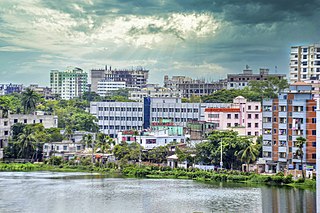Related Research Articles

Huseyn Shaheed Suhrawardy was a Bengali barrister and politician. He served as the Prime Minister of Pakistan from 1956 to 1957 and before that as the Prime Minister of Bengal from 1946 to 1947 in British India. In Pakistan, Suhrawardy is revered as one of the country's founding statesmen. In Bangladesh, Suhrawardy is remembered as the mentor of Bangladesh's founding leader Sheikh Mujibur Rahman. In India, he is seen as a controversial figure; some hold him responsible for the 1946 Calcutta Killings, for which he is often referred as the "Butcher of Bengal” in West Bengal. In India he is also remembered for his performance as the Minister for Civil Supply during the Bengal famine of 1943.

Sunamganj is a district located in north-eastern Bangladesh within the Sylhet Division.

Khadi, derived from khaddar, is a hand-spun and woven natural fibre cloth promoted by Mahatma Gandhi as swadeshi (self-sufficiency) for the freedom struggle of the Indian subcontinent, and the term is used throughout India, Pakistan and Bangladesh. The first piece of the hand-woven cloth was manufactured in the Sabarmati Ashram during 1917–18. The coarseness of the cloth led Gandhi to call it khadi. The cloth is made from cotton, but it may also include silk or wool, which are all spun into yarn on a charkha. It is a versatile fabric that remains cool in summer and warm in winter. To improve its appearance, khadi is sometimes starched to give it a stiffer feel. It is widely accepted in various fashion circles. Popular dresses are made using khadi cloth such as dhoti, kurta, and handloom saris such as Puttapaka Saree, Kotpad Handloom fabrics, Chamba Rumal, and Tussar silk. Gajam Anjaiah, an Indian master handloom designer and a recipient of the Padma Shri, is known for his innovation and development of tie-dye handloom products along with the Telia Rumal technique of weaving products based on the Ikat process.

Direct Action Day, also known as the 1946 Calcutta Killings, was a day of nationwide communal riots. It led to large-scale violence between Muslims and Hindus in the city of Calcutta in the Bengal province of British India. The day also marked the start of what is known as The Week of the Long Knives. While there is a certain degree of consensus on the magnitude of the killings, including their short-term consequences, controversy remains regarding the exact sequence of events, the various actors' responsibility and the long-term political consequences.

The Partition of Bengal in 1947, part of the Partition of India, divided the British Indian province of Bengal based on the Radcliffe Line between the Dominion of India and the Dominion of Pakistan. The Hindu-majority West Bengal became a state of India, and the Muslim-majority East Bengal became a province of Pakistan.

Dhirendranath Datta was a Bengali lawyer by profession who was also active in the politics of undivided Bengal in pre-partition India, and later in East Pakistan (1947–1971).
East Bengali Refugees are people who left East Bengal following the Partition of Bengal, which was part of the Independence of India and Pakistan in 1947. An overwhelming majority of these refugees and immigrants were Bengali Hindus. During the Bangladesh liberation war with West Pakistan, an estimated 10 million people of East Pakistan fled the country and took refuge in India particularly in the Indian states of West Bengal and Indian North East region, especially Tripura and Assam.

Leela Roynée Nag, was a radical leftist Indian woman politician and reformer, and a close associate of Netaji Subhash Chandra Bose. She was born in Goalpara, Assam to Girish Chandra Naag, who was a deputy magistrate, and her mother was Kunjalata Naag. She was the first female student of Dhaka University.

United Bengal was a proposal to transform Bengal Province into an undivided, sovereign state at the time of the Partition of India in 1947. It sought to prevent the division of Bengal on religious grounds. The proposed state was to be called the Free State of Bengal. A confessionalist political system was mooted. The proposal was not put up for a vote. The British government proceeded to partition Bengal in accordance with the Mountbatten Plan and Radcliffe Line.

Comilla, officially spelled Cumilla, is the fifth largest city of Bangladesh and second largest in Chittagong division. It is the administrative centre of the Comilla District. The name Comilla was derived from Komolangko (কমলাঙ্ক), meaning the pond of lotus.

The Noakhali riots were a series of semi-organized massacres, rapes and abductions, combined with looting and arson of Hindu properties, perpetrated by the Muslim community in the districts of Noakhali in the Chittagong Division of Bengal in October–November 1946, a year before India's independence from British rule.

The Pakistan National Congress (PNC), later known as the Bangladesh National Congress, was a political party that mainly represented the Hindus and other religious minorities in Pakistan. The party championed secularism in the Muslim-dominated state, and its electoral and organisational strength was mainly based in East Bengal.

The 1964 East Pakistan Riots refer to the massacre and ethnic cleansing of Bengali Hindus from East Pakistan in the wake of an alleged theft of what was believed to be the Prophet's hair from the Hazratbal shrine in Jammu and Kashmir in India. The salient feature of the pogroms was its urban nature and selective targeting of Bengali Hindu owned industries and merchant establishments in the capital city of Dhaka. This resulted in unending waves of Bengali Hindu refugees in neighbouring West Bengal. The refugee rehabilitation became a national problem in India, and hundreds of refugees were resettled in Dandakaranya region of Odisha & Madhya Pradesh.

The 1950 East Pakistan riots took place between Hindus and Muslims in East Pakistan, which resulted in hundreds of thousands of Hindus being killed in pogroms.
Jharna Dhara Chowdhury was a Bangladeshi social activist.

The 1947 Sylhet referendum was held in the Sylhet District of the Assam Province of British India to decide whether the district would remain in Undivided Assam and therefore within the post-independence Dominion of India, or leave Assam for East Bengal and consequently join the newly-created Dominion of Pakistan. The referendum's turnout was in favour of joining the Pakistani union; however, the district's Karimganj subdivision remained within the Indian state of Assam.

Suhasini Ganguly was an Indian woman freedom fighter who participated in the Indian independence movement.

Boro Maa was a matriarch of the Matua Mahasangha, a Hindu religious reformation movement. Her original name was Binapani Devi Thakur; the name "Boro Maa" translates to "elder mother", an epithet for universal mother of Matua Community. She along with her husband Pramatha Ranjan Thakur established the community's new capital at Thakurnagar.
Ashalata Sen was an activist, poet, social worker, and a leading figure in the Indian independence movement.
Noakhailla (নোয়াখাইল্লা), also known by the exonym Noakhalian, is a dialect of Bengali, spoken by an estimated 7 million people, primarily in the Greater Noakhali region of Bangladesh as well as southern parts of Tripura in India. Outside of these regions, there are substantial numbers of Noakhailla speakers in other parts of Bangladesh; as well as diaspora communities in the Middle East, Italy, Europe and the United States.
References
- ↑ The trauma and the triumph : gender and partition in eastern India. Bagchi, Jasodhara., Ghosh, Subhasri. Kolkata: Stree. 2009. p. 168. ISBN 978-81-85604-55-8. OCLC 53950927.
{{cite book}}: CS1 maint: others (link) - 1 2 3 4 5 6 7 8 "ব্রিটিশ বিরোধী আন্দোলনের নেত্রী সুহাসিনী দাস মারা গেছেন". bangla.bdnews24.com (in Bengali). Retrieved 2020-08-02.
- 1 2 3 4 5 6 7 Roychoudhury, H P. (2016). Silent Patriot Of Bangladesh. Partridge India. ISBN 978-1-4828-8688-7. OCLC 1152212635.
- 1 2 3 4 5 6 7 "সুহাসিনী দাস - Golden Femina". www.goldenfeminabd.com. Retrieved 2020-08-02.
- 1 2 Hossain, Ashfaque (2013). "The Making and Unmaking of Assam-Bengal Borders and the Sylhet Referendum*". Modern Asian Studies. 47 (1): 250–287. doi:10.1017/S0026749X1200056X. ISSN 0026-749X. S2CID 145546471.
- 1 2 "সুহাসিনী দাস ও তাঁর 'দেশ বিভাগের ডায়েরি' | দৈনিক ইত্তেফাক ঈদ সংখ্যা | The Daily Ittefaq". archive1.ittefaq.com.bd. Retrieved 2020-08-02.
- ↑ "Quit India Movement: Sylhet experience | Bangladesh on Record" . Retrieved 2022-02-07.
- ↑ "510 Suhasini Das, A partition diary". www.india-seminar.com. Retrieved 2020-08-02.
- 1 2 Khan, Yasmin, 1977- (2007). The great Partition : the making of India and Pakistan. New Haven [Conn.]: Yale University Press. p. 146. ISBN 978-0-300-12078-3. OCLC 87504568.
{{cite book}}: CS1 maint: multiple names: authors list (link) - ↑ Ghosh, Biswaroop (2011). "Religion and Politics in Bengal: The Noakhali Carnage 1946-47". Proceedings of the Indian History Congress. 72: 944. ISSN 2249-1937. JSTOR 44146785.
- ↑ "বিখ্যাত ব্যক্তিত্ব". 2011-06-23. Archived from the original on 2011-06-23. Retrieved 2020-07-28.
- ↑ Baragohāñi, Nirupamā, 1932- (1999). Abhiyatri = One life many rivers. Borgohain, Pradipta, 1962-. New Delhi: Sahitya Akademi. p. 168. ISBN 81-260-0688-9. OCLC 42960487.
{{cite book}}: CS1 maint: multiple names: authors list (link) - ↑ "Recovering Sylhet". Himal Southasian. 2012-11-22. Retrieved 2020-08-02.
- ↑ Dutta, Binayak (2016). "IN THE SHADOWS OF VIOLENCE: MIGRATION, PERCEPTIONS OF SECURITY AND TALES OF HORROR IN POST-PARTITION NORTH EAST INDIA" (PDF).
- ↑ "SAU::Sylhet Agricultural University". www.sau.ac.bd. Retrieved 2020-08-02.